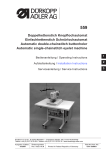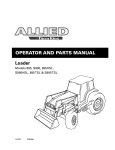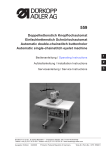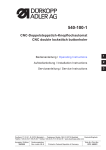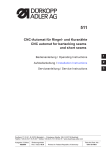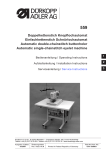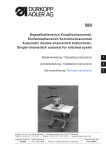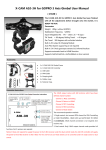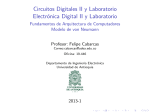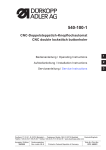Download DURKOPP ADLER 540 - 100 Operating instructions
Transcript
540-100-1 CNC-Doppelsteppstich-Knopflochautomat CNC double lockstitch buttonholer Bedienanleitung / Operating Instructions 1 Aufstellanleitung / Installation Instructions 2 Serviceanleitung / Service Instructions 3 Postfach 17 03 51, D-33703 Bielefeld Potsdamer Straße 190, D-33719 Bielefeld Deutsch/Englisch Telefon +49 (0) 5 21/ 59 25-00 Telefax +49 (0) 5 21/ 9 25 24 35 www.duerkopp-adler.com Ausgabe / Edition: 09/2009 Änderungsindex Rev. index: 01.0 Printed in Federal Republic of Germany Teile-Nr.:/Part-No.: 0791 540001 Alle Rechte vorbehalten. Eigentum der Dürkopp Adler AG und urheberrechtlich geschützt. Jede, auch auszugsweise Wiederverwendung dieser Inhalte ist ohne vorheriges schriftliches Einverständnis der Dürkopp Adler AG verboten. All rights reserved. Property of Dürkopp Adler AG and copyrighted. Reproduction or publication of the content in any manner, even in extracts, without prior written permission of Dürkopp Adler AG, is prohibited. Copyright ã 2009 - Dürkopp Adler AG Foreword This instruction manual is intended to help the user to become familiar with the machine and take advantage of its application possibilities in accordance with the recommendations. The instruction manual contains important information on how to operate the machine securely, properly and economically. Observation of the instructions eliminates danger, reduces costs for repair and down-times, and increases the reliability and life of the machine. The instruction manual is intended to complement existing national accident prevention and environment protection regulations. The instruction manual must always be available at the machine/sewing unit. The instruction manual must be read and applied by any person that is authorized to work on the machine/sewing unit. This means: – – – Operation, including equipping, troubleshooting during the work cycle, removing of fabric waste, Service (maintenance, inspection, repair) and/or Transport. The user also has to assure that only authorized personnel work on the machine. The user is obliged to check the machine at least once per shift for apparent damages and to immediatly report any changes (including the performance in service), which impair the safety. The user company must ensure that the machine is only operated in perfect working order. Never remove or disable any safety devices. If safety devices need to be removed for equipping, repairing or maintaining, the safety devices must be remounted directly after completion of the maintenance and repair work. Unauthorized modification of the machine rules out liability of the manufacturer for damage resulting from this. Observe all safety and danger recommendations on the machine/unit! The yellow-and-black striped surfaces designate permanend danger areas, eg danger of squashing, cutting, shearing or collision. Besides the recommendations in this instruction manual also observe the general safety and accident prevention regulations! General safety instructions The non-observance of the following safety instructions can cause bodily injuries or damages to the machine. 1. The machine must only be commissioned in full knowledge of the instruction book and operated by persons with appropriate training. 2. Before putting into service also read the safety rules and instructions of the motor supplier. 3. The machine must be used only for the purpose intended. Use of the machine without the safety devices is not permitted. Observe all the relevant safety regulations. 4. When gauge parts are exchanged (e.g. needle, presser foot, needle plate, feed dog and bobbin) when threading, when the workplace is left, and during service work, the machine must be disconnected from the mains by switching off the master switch or disconnecting the mains plug. 5. Daily servicing work must be carried out only by appropriately trained persons. 6. Repairs, conversion and special maintenance work must only be carried out by technicians or persons with appropriate training. 7. For service or repair work on pneumatic systems, disconnect the machine from the compressed air supply system (max. 7-10 bar). Before disconnecting, reduce the pressure of the maintenance unit. Exceptions to this are only adjustments and functions checks made by appropriately trained technicians. 8. Work on the electrical equipment must be carried out only by electricians or appropriately trained persons. 9. Work on parts and systems under electric current is not permitted, except as specified in regulations DIN VDE 0105. 10. Conversion or changes to the machine must be authorized by us and made only in adherence to all safety regulations. 11. For repairs, only replacement parts approved by us must be used. 12. Commissioning of the sewing head is prohibited until such time as the entire sewing unit is found to comply with EC directives. 13. The line cord should be equipped with a country-specific mains plug. This work must be carried out by appropriately trained technicians (see paragraph 8). It is absolutely necessary to respect the safety instructions marked by these signs. Danger of bodily injuries ! Please note also the general safety instructions. Contents Page: Part 2: Installation Instructions Class 540-100-1 1. Scope of delivery. . . . . . . . . . . . . . . . . . . . . . . . . . . . . . . . . . . . . . . . . . . . . . 3 2. 2.1 General and Transportation Safety Ring bolt . . . . . . . . . . . . . . . . . . . . . . . . . . . . . . . . . . . . . . . . . . . . . . . . . . . 3 3. 3.1 3.2 Equipment Structure of equipment . . . . . . . . . . . . . . . . . . . . . . . . . . . . . . . . . . . . . . . . . . . Available equipment . . . . . . . . . . . . . . . . . . . . . . . . . . . . . . . . . . . . . . . . . . . . 4 5 4. 4.1 Optional equipment Positioning aids . . . . . . . . . . . . . . . . . . . . . . . . . . . . . . . . . . . . . . . . . . . . . . . 7 5. 5.1 5.2 5.3 5.4 5.5 5.5.1 5.5.2 5.5.3 5.5.4 5.6 5.7 5.8 5.9 Assembling the sewing automat Making the table top . . . . . . . . . . . . . . . . . Mounting the frame . . . . . . . . . . . . . . . . . . Completion and mounting of table top . . . . . . . Setting the working height . . . . . . . . . . . . . . Setting up the machine head . . . . . . . . . . . . Lengthwise installation . . . . . . . . . . . . . . . . Widthwise installation. . . . . . . . . . . . . . . . . Swivel device (optional) . . . . . . . . . . . . . . . Needle cooler (optional) . . . . . . . . . . . . . . . Mounting the control unit . . . . . . . . . . . . . . . Mounting the waste container . . . . . . . . . . . . Mounting the maintenance unit and the set value Mounting the pedal and the traction rod . . . . . 6. 6.1 6.2 6.3 6.4 Electrical connection Plug connections at the multiple pin Plug connections at the multiple pin Potential compensation . . . . . . . Control connection to main switch . . . . . . . . . . . . . . . . . . . . . . . . . . . . . . . . . . . . . . . . . . . . . . . . . . . . . . . . . . . . . . . . . . . . . . . . . . . . . . . . . . . . . . . . . . . . . . . . . . . . . . . . . . . . . . . . . . . . . . . . . . . . . . . . . . . . . . . . . . . . . . . . . . . . . . . . . . . . . . . . . . . . . . . . . . . . . . . . . . . . . . . . . . . . . . . . . . . . . . . . . . . . . . . . . . . . . . . . . . . . . . . . . . . . . . . . . . . . . . . . . . . . . . . . . . . . . . . . . . . . . . . . . . . . . . . . . . . 8 9 10 11 11 11 11 12 13 15 15 15 15 . . . . . . . . . . . . . . . . . . . . . . . . . . . . . . . . . . . . . . . . . . . . . . . . . . . . . . . . . . . . . . . . . . . . . . . . . . . . . . . . . . . . 16 17 17 18 7. 7.1 7.2 Pneumatic connection Connecting the maintenance unit . . . . . . . . . . . . . . . . . . . . . . . . . . . . . . . . . . . . Connecting the waste container . . . . . . . . . . . . . . . . . . . . . . . . . . . . . . . . . . . . . 19 19 8. 8.1 Oil lubrication Filling the oil reservoir . . . . . . . . . . . . . . . . . . . . . . . . . . . . . . . . . . . . . . . . . . . 20 9. 9.1 9.2 9.2.1 9.2.2 9.2.3 9.3 Software installation Standard delivery . . . . . . Software installation . . . . General . . . . . . . . . . . . Loading the program . . . . Dongle-Update via Internet Language setting . . . . . . . . . . . . 21 21 21 22 23 23 10. Sewing test . . . . . . . . . . . . . . . . . . . . . . . . . . . . . . . . . . . . . . . . . . . . . . . . . 24 . . . . . . . . . . . . . . . . . . . . . . . . . . . . . . strip strip . . . . . . . . . . . . . . . . . . . . . . . . . . . . . . . . . . . . . . . . . . . . . . . . . . . . . . . . . . . . . . . . . . . . . . . . . . . . . . . initiator . . . . . (4-fold) . (15 fold) . . . . . . . . . . . . . . . . . . . . . . . . . . . . . . . . . . . . . . . . . . . . . . . . . . . . . . . . . . . . . . . . . . . . . . . . . . . . . . . . . . . . . . . . . . . . . . . . . . . . . . . . . . . . . . . . . . . . . . . . . . . . . . . . . . . . . . . . . . . . . . . . . . . . . . . . . . . . . . . . . . . . . . . . . . . . . . . . . . . . . . . . . . . . . . . . . . . . . . . . . . . . . . . . . . . . . . . . . . . . . . . . . . . . . 2 8 1 2 5 11 12 4 7 9 3 6 10 1. Scope of delivery The scope of delivery is dependent upon your order. Please check that all necessary parts are present. – – – – – – – – – 1 Machine head 2 Control 3 Maintenance unit 4 Set value initiator 5 Waste container 6 Traction rod 7 Main switch 8 Thread stand Small parts in the accessories pack Only with delivery of frame (optional) – 9 Frame – 10 Pedal – 11 Table top – 12 Drawer 2 2. General and Transportation Safety ATTENTION ! The sewing automat 540 must only be installed by trained specialist staff ! Transport securing devices If you have bought an assembled buttonholer; the following transport securing devices have to be removed: Securing tapes and wood battens at machine head, table and stand. 2.1 Ring bolt The ring bolt makes it easier to lift the automat onto the frame. You can lift the automat using a ceiling crane or two people can lift the automat using a stable bar putting it through the ring bolt. The ring bolts are in the accessories pack. – Screw the ring bolt in the case lid of the machine head. – Lift the machine head onto the table plate. – Remove the ring bolt. 3 3. Equipment 3.1 Structure of Equipment Equipment: E 126/22 Cutting 1 = Cutting equipment with slit in the throat plate Throat plate/basket 1 = blouses, shirts raised throat plate (0,6 mm); basket sole cross toothed 2 = working clothes, heavy material flat throat plate; basket sole cross toothed 3 = ties, cuffs flat throat plate; basket sole cross toothed, narrow 4 = polo shirts flat throat plate; basket sole cross toothed, single side narrow, sewing basket steep sided 5 = ladies outer wear, working clothes, sports and leisure wear with varying material thickness throat plate not raised; basket sole layered with Vulkollan foam to even out level differences 6 = knitwear throat plate sharply raised (1,6 mm); basket sole toothed Stitch row width 3 = stitch row width max. 3 mm 4 = stitch row width max. 4 mm 6 = stitch row width max. 6 mm Sewing area and basket length 22 35 48 70 3.1.1 = = = = Buttonhole Buttonhole Buttonhole Buttonhole length length length length to to to to max. max. max. max. 22 35 48 70 mm mm mm mm Sewing automat equipment components The components for up-to-date equipment can be found at www.duerkopp-adler.com in the Download area. 4 3.2 Available equipment 540 E 113/22 Sewing equipment for buttonholes in shirts and blouses, closely woven material, max. buttonhole width 3 mm, max. buttonhole length 22 mm. 540 E 114/22 Sewing equipment for buttonholes in shirts and blouses, closely woven material, max. buttonhole width 4 mm, max. buttonhole length 22 mm. 540 E 114/35 Sewing equipment for buttonholes in shirts and blouses, closely woven material, max. buttonhole width 4 mm, max. buttonhole length 35 mm. 540 E 154/22 Sewing equipment for buttonholes in ladies outer wear, working clothes, sportswear and casual wear with cloth presser basket compensating the height differences, max. buttonhole width 4 mm, max. buttonhole length 22 mm. 540 E 154/35 Sewing equipment for buttonholes in ladies outer wear, working clothes, sportswear and casual wear with cloth presser basket compensating the height differences, max. buttonhole width 4 mm, max. buttonhole length 35 mm. 540 E 156/35 Sewing equipment for buttonholes in ladies outer wear, working clothes, sportswear and casual wear with cloth presser basket compensating the height differences, max. buttonhole width 6 mm, max. buttonhole length 35 mm. 540 E 133/22 Sewing equipment for buttonholes in collars of shirts and blouses and cuffs, with a narrow cloth presser basket, max. buttonhole width 3 mm, max. buttonhole length 22 mm. 540 E 134/22 Sewing equipment for buttonholes in collars of shirts and blouses and cuffs, with a special cloth presser basket , max. buttonhole width 4 mm, max. buttonhole length 22 mm 540 E 146/22 Sewing equipment for buttonholes in Polo shirts, max. buttonhole width 6 mm, max. buttonhole length 22 mm. 540 E 166/22 Sewing equipment for buttonholes in woven and knitted fabrics, max. buttonhole width 6 mm, max. buttonhole length 22 mm. 540 E 166/35 Sewing equipment for buttonholes in woven and knitted fabrics, max. buttonhole width 6 mm, max. buttonhole length 35 mm. 540 E 126/22 Sewing equipment for buttonholes in working clothes, medium weight material, max. buttonhole width 6 mm, max. buttonhole length 22 mm. 540 E 126/35 Sewing equipment for buttonholes in working clothes, medium weight material, max. buttonhole width 6 mm, max. buttonhole length 35 mm. 540 E 126/48 Sewing equipment for buttonholes in working clothes, medium weight material, max. buttonhole width 6 mm, max. buttonhole length 48 mm. 540 E 126/70 Sewing equipment for buttonholes in seat belt openings in stroller and infant safety seat, max. buttonhole width 6 mm, max. buttonhole length 70 mm. 2 5 4. 6 Optional equipment 0540 211324 Cloth presser basket coated with Vulkollan (only for E 113/22) and smooth material slider for buttonholes in shirts and blouses, prevents impressions in sensitive material. 0540 211424 Cloth presser basket coated with Vulkollan (only for E 114/22) and smooth material slide for buttonholes in shirts and blouses, prevents impressions in sensitive material. 0540 211434 Cloth presser basket coated with Vulkollan (only for E 114/35) and smooth material slide for buttonholes in shirts and blouses, prevents impressions in sensitive material. 0540 590064 Swivel device for rapid change between lengthwise and widthwise installation, for a flexible mode of operation. 0540 590014 Pneumatic needle cooler. 9822 510026 Halogen tripod – sewing light incl. transformer, 1 x 190-240V/12V sec. = 20 Watt (additionally needed are a table clamp and a connection kit). 9822 510027 Table clamp (for sewing light 9822 510026). 9870 001021 Sewing lamp connection kit (electrical connection for sewing light 9822 510026). 4.1 Positioning aids Part No. 0540 590144 Spacing ruler with lateral guide for linen buttonholes in the front welt of men’s shirts and ladies’ blouses. 2 Part No. 0540 590154 Template positioning aid for collar tips, collar welts, cuffs, double cuffs and shirt flaps. The enclosed cardboard templates (5 pieces) are to be cut according to the form of the piece of clothing that is to be sewn. By turning the template only one template is needed for the sewing process, f. e. first sew the left collar welts and then the right collar welts with it. 7 5. Assembling the sewing automat 5.1 Making the table top If you are manufacturing your own table top then use the measurements in figure 1. Part number: 0700 054003 1 Punch mark on the bottom 2 Table plate bottom 1 2 Fig. 1 8 5.2 Mounting the frame – – – Mount the frame as shown in figure 2 To ensure a safe standing, all 4 feet have to have contact with the ground. Screw the oil can onto the frame bar. 2 Fig. 2 9 5.3 Completion and mounting of table top If you are mounting the table top yourself then please use the measurements in figure 2. – Screw cable channel 1 onto the table top. – Screw the mount for drawer 2 onto the table top. – Screw the main switch 3 onto the table top. – Fasten the table top onto the frame with four wood screws (B8 x 35). 3 1 2 Fig. 2 10 5.4 Setting the working height The working height is adjustable. – Loosen both screws 5 on each of the frame bars. – Set the desired working height. Ensure that if possible both sides are pulled out or pushed in evenly. – Tighten both screws 5 again. 5 5.5 Setting up the machine head When taking the machine head out of the transport box, do not grab hold of the blocks, the cloth press plate or the control panel. Make sure that the oil reservoir is taped up to prevent that oil escapes during the set up. The machine head can be mounted lengthwise or widthwise. A swivel device is optionally available allowing lengthwise or widthwise installation to be changed quickly. 2 5.5.1 Fig. 1 Lengthwise installation – – – Place the machine head on the table plate according to figure 1. Feed all cables and hoses through the bore hole in the table top. Set the machine head and screw it to the table top, according to figure 2, using 4 hexagonal screws . – – – Place the machine head on the table plate according to figure 1. Feed all cables and hoses through the bore hole in the table top. Set the machine head and screw it to the table plate, according to figure 3, using 4 hexagonal screws . Fig. 2 5.5.2 Widthwise installation Fig. 3 11 5.5.3 Swivel device (optional) – – – – – – – – – – – – – Fig. 1 12 Loosen all cables and hoses, connected to the machine head under the table top. Unscrew the fastening screws of the machine head under the table top. Screw on the L-bracket 10 for the thread stand on the rear of the bed plate. Please use the provided screws 1 (2x), washer 2 (4x) und nuts 3 (2x). Set aside the machine head (Fig. 1) Note: Make sure that the oil reservoir is taped up to avoid oil leak. Fix the plastic fittings 4 with the nut 5 on the hinged plate 6. Slide the felt 7 over the fitting 4. Feed all cables and hoses through the fitting 4. For this purpose, the housing of the plug x120b must be dismantled. Screw the hinged plate 6 under the bed plate. For this purpose, screw the threaded pin 8 (4x) on the rubber feet of the bed plate and secure the hinged plate using the falt nuts 9 (4x). After tightening the threaded pin, those must be flush with. They should in any case not be sticking out of the nuts. Feed all cables and hoses through the bore hole in the table top. Set the machine head with the swivel device on the bore holes of the table top. Connect the cables and the hoses. Screw the thread stand on the L-bracket 10. Arrest the machine head lengthwise or widthwise using the set screw 11. 5.5.4 Needle cooler (optional) Function The needle cooler operates parallel to the scissors pivoting cylinder. This means that the needle cooler is active while the scissors are swung out. 21 25 23 22 24 Installation – Screw the throttle 21 into the tap hole of the scissors block. – Push the blower pipe 22 with its long arm into the throttle nozzle. The position of the air outlet can be varied by turning and pulling out the blower pipe. – Cut the pneumatic line 23 leading to the pivoting cylinder 5 cm underneath the arm outlet. – Insert the Y-piece. – Lay a new pneumatic line from the connection 24 on the scissors block to the Y-piece. – Shut the throttle 21 by turning the throttle screw 25 clockwise. – Switch the machine on. – Skip to the service menu. – Select the menu item T3.1.1 outputs. Activate the output Y2 for the swinging out of the scissors. – The throttle 21 of the needle cooler now receives compressed air. Adjust the desired air-flow by opening the throttle screw 25. – Quit the service menu by actuating the ESC key. – Test the function of the scissors swinging out by sewing a test seam. Attention! Do not open the throttle completely. If the air-flow on the needle cooler gets too strong, it impairs the swinging out of the needle thread scissors. 13 2 Notes: 14 5.6 Mounting the control unit – Mount the control unit (DAC III) onto the table plate using 4 wood screws according to figure 2 on page 10. The side with the bushes for the motors (three bushes, one under the other) has to point to the right side. 5.7 Mounting the waste container 1 2 3 – – – – – – Remove cover 1 of the waste container. Take the filter fleece 2 out of cover 1. Screw cover 1 onto the table plate with two wood screws. Refit the filter fleece 2 into the cover 1. Refit the fleece clamping plate. Finally stick the container 4 onto the cover 1. 4 2 5.8 Mounting the maintenance unit and the set value initiator – – Screw plate 5 onto the set value initiator 6. Screw the set value initiator plate 6 to the maintenance unit 6 L-bracket 7 on the cross strut of the frame 8 according to figure 4. 5 7 8 5.9 Mounting the pedal and the traction rod – – – – – Screw pedal 9 onto the frame strut 10. For ergonomic reasons the pedal center should be directly under the needle. Fasten the traction rod 11 to the set value initiator 12 and the pedal 9. Loosen screw 13 on the traction rod 11. Set the length of the traction rod 11 so that pedal 9, without any pressure on it, has an inclination of about 10°. Tighten screw 13 again. 9 10 12 13 11 15 6. Electrical connection 6.1 Plug connections at the multiple pin strip (4-fold) 1 2 3 x20 x30 x40 16 Connect the plug connectors of the linen buttonhole automat as follows: – 4-pole Plug connector 1 è Sewing motor connector – 5-pole Plug connector 2 è Stepping motor for the X-drive – 5-pole Plug connector 3 è Stepping motor for Y-drive 6.2 Plug connections at the multiple pin strip (15 fold) 4 8 5 6 10 7 9 2 Connect the plug connectors of the buttonhole automat, the set value initiator and the control panel as follows: x140b – x140t – x300b – x170 – x120b – x110 – REF-signals Light barrier plug /sensor on plug connector 4 Note: 8-pole plug is coded. Plug PWM (optional with the electronic thread tensioner) Magnetic plugs on plug connector 8 Note: 8-pole plug is coded. Encoder plug sewing motor Encoder plug signal sewing motor on plug connector 5 Control panel plug Control panel plug on plug connector 6 Plug I/O 1-8 Operating device plug (pedal switch) via adapter 9 on plug connector 7 Test-Interface 10 Dongle 6.3 Potential compensation – Screw the potential compensation cable onto the control panel. 11 17 6.4 Control connection to main switch CAUTION ! All work that needs to be carried out on the electrical installation of the linen buttonhole automat is only allowed to be carried out by an electrician or other qualified personal. The mains plug is to be unplugged! 2 1 4 – – – – – – – – 5 18 3 Remove rotary knob 1. To do this loosen the screw 2 in the rotary knob. Remove the cover 3 from the main switch. To do this use a screwdriver to unlock the latch in bore hole 4. Place the cable from the control box in the cable channel. Feed the cable into the main switch. Connect the cable cores of the control box to the screws “T1" and “T2". Connect the earth connection of the control box to the main switch. Refit the cover to the main switch. Refit the rotary knob and tighten it. 7. Pneumatic connection 7.1 Connecting the maintenance unit 9 – – – Connect the air hose 6 to the coupling. Connect the hose nozzle 7 with an air hose onto its air supply connection. A pneumatic connection kit for the connection onto the existing air pressure network is available under order number: 0797 003031. Connect the cable 9 to the pneumatic switch 8. 6 8 7 2 CAUTION! The operating pressure is 6 bar. Check the maintenance unit to see whether 6 bar are indicated! If necessary, adjust the pressure on the maintenance unit to 6 bar. 7.2 Connecting the waste container – – Connect the air hose 8 (the thinner one of the two black air hoses) to the waste container. Connect the hose 9 to the waste container. Hose 9 is used to exhaust cutting waste. 8 9 19 8. Oil lubrication Caution: Danger of injury ! Oil can cause skin eruption. Avoid protracted contact with the skin. In the event of contact, thoroughly wash the affected area. ATTENTION ! The handling and disposal of mineral oils is subject to legal regulations. Deliver used oil to an authorized collecting station. Protect your environment. Take care not to spill oil. Fill up the oil reservoirs exclusively with lubricating oil DA-10 or an equivalent oil with the following specification: – Viscosity at 40°C: 10 mm²/s – Ignition point: 150°C The oil can be bought at the sales points of DÜRKOPP ADLER AG under the following parts numbers: 250-ml-Container: 9047 000011 1-Litre-Container: 9047 000012 2-Litre-Container: 9047 000013 5-Litre-Container: 9047 000014 8.1 Filling the oil reservoir – – Fill the oil reservoirs 1 and 2 through the hole in the inspection glasses. The oil level has to be between min. and max. 1 2 20 9. Software installation 9.1 Standard delivery With delivery of the sewing automat only the test software is installed in the control unit, which allows the loading of specific sewing software from the boot-dongle. The boot-dongle is in the machine head accessories pack. CAUTION! Only use the boot-dongle, that comes with the machine head. Using a dongle that contains the software of another machine class can cause damage to the sewing automat! 9.2 Software installation 9.2.1 General Loading a specific sewing software in the DACIII control unit is possible with the help of the “Programmed Dongle”. The “Programmed Dongle” has a label indicating the class and software version. Such a loading (booting) may be used in order to provide several DACIII control unit with a sewing software (first installation) or to install a newer machine software (update). With the delivery of the machine only the test software (allowing the loading of sewing software) is installed in the control unit. The test software offers no further functions. If the test software gets damaged during the loading process, it is no longer possible to load a software using a dongle. In such a case use a PC with a loader cable. The detailed procedure for this is described at the homepage of Dürkopp Adler AG “www.duerkopp-adler.com” among the section of “Download Area” and “Software”. CAUTION ! Turn off the main switch before connecting the dongle. 21 2 9.2.2 Loading the program – Turn the machine off at the main switch. – Insert the dongle 2 into the socket X110 (TEST-Interface) 1 of the control unit (see pictures). Switch on the main switch. The Software will be loaded. The loading process takes less than 60 seconds. During the loading process do not remove the dongle and do not switch off the machine. The machine proceeds with a warm start after the software is loaded. – – – – – Remove the dongle 2. If necessary confirm the software version (caution: the machine software must match the machine class). The sub menu for the input of basket width and basket length (T1.4) will automatically be shown on the control panel. The length and width of the sewing basket has to be entered here. This setting only needs to be done with the initial installation. – Press the OK key. – Select the basket length of the sewing basket that is to be used with the arrow keys ñò . If you are using your own sewing basket choose ´X´ as basket length and press the OK key. Set the desired value with the arrow keys ñò. Select the position to be edited with the keys ïð. At the end press the OK key. – With the arrow key ò select the menu point basket width. Press the OK key. – Select the basket length of the sewing basket with the arrow keysñò. If you are using your own sewing basket, choose ´X´ as basket width and press the OK key. Select the desired value with the arrow keys ñò. Select the position to be edited with the keys ïð . At the end press the OK key. – Press the ESC key. The main menu will be shown. CAUTION! Incorrect setting of the basket length and basket width causes damage to the sewing automat. – The machine is now ready for use. 1 2 22 Important ! During the loading process do not remove the dongle and do not switch off the machine (you will damage the Software)! Remove the dongle before the next switch-on, otherwise the sewing software will be reloaded again. 9.2.3 Dongle-Update via Internet Dongles can be updated with programs available from the Dürkopp Adler homepage. Please open our homepage “www.duerkopp-adler.com” where you will find the relevant programs in the “Download” - section. Prerequisite is our auxiliary download software “Dongle Copy” which is available in the same section together with instructions for easy use. 9.3 Language setting The menu language can only be changed after the basket length and basket width have been set during the initial installation of the sewing software. The choices are English (standard setting), German and parameter. To change the menu language proceed as follows: – Press the F key. The menu point input code will be shown. – Enter technician code 25483. Change the value with the arrow keys ñò, select the position to be changed with the arrow keys ïð. Confirm by pressing the OK key. – Select the menu point User Settings with the arrow keys ñò. Press the OK key – Select the menu point Language with the arrow keys ñò. Press the OK key. – Select the desired language (German, English, Parameter) with the arrow keys ñò . Press the OK key. A tick is shown behind the chosen language. – Press the ESC key to complete. The main menu will be shown. 23 2 10. Sewing test After completion of the assembly, a sewing test should be made. – Wind up bobbin thread (see operating instructions chapter 3.2) Caution: Danger of injury ! Switch off main switch. Thread in the needle and bobbin thread only when the sewing automat is switched off. – – – – – – 24 Thread in the needle thread (see operating instructions chapter 3.1). Place the bobbin and its housing (see operating instructions chapter 3.2 and 3.3). Switch on main switch. The control unit is initialized. Choose a workpiece to be processed. Begin with a low speed at first (see operating instructions). Gradually increase the speed. Check that the buttonhole meets the desired requirements. If not: Alter the thread tension (see operating instructions chapter 3.7). If needed please check also the setting instructions described in the service instructions.




























